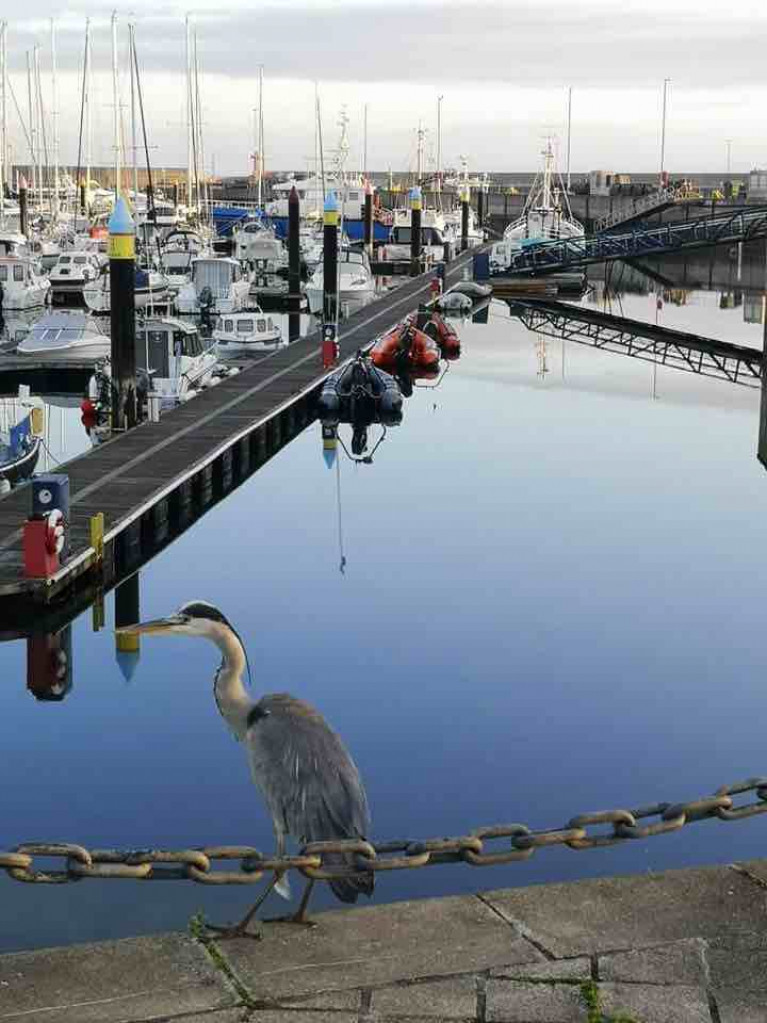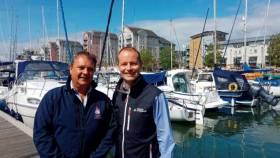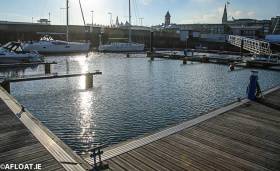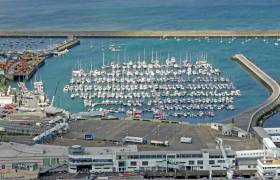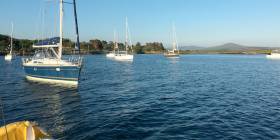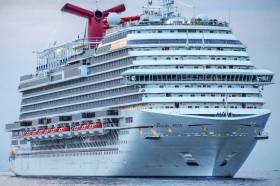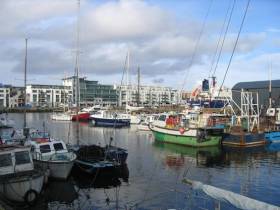Displaying items by tag: Marinas
An Taisce has announced the recipients of the International Blue Flag and the National Green Coast Awards for 2023.
All ten marinas awarded in 2022 have retained Blue Flag status for the coming season. (Download PDF below for recipients).
A total of 159 awards, an increase of two awards compared to 2022, were presented by the Minister for Housing, Local Government and Heritage, Mr. Darragh O’Brien, TD, at an awards ceremony held on the Shoreline Hotel, overlooking Donabate's Balcarrick Blue Flag beach in Co. Dublin. The event was organised in collaboration with Fingal County Council.
Speaking at the awards ceremony Minister O’Brien said: "This year celebrates the 20th anniversary of Clean Coasts and the Green Coast Awards, and I am delighted to present a record-breaking 65 Green Coast Awards today. It also marks 36 years of the Blue Flag as an international programme and I am pleased to present 94 Blue Flags for the 2023 season. During its 36 years, the Blue Flag has become an internationally recognised symbol of high standards in water quality, environmental management, environmental education and safety. Today’s high number of awards is a testament to the hard work and dedication of the local authorities, An Taisce, local coastal communities and other volunteers around the country.”
 Kinsale Yacht Club marina in West Cork with its blue flag flying over the marina entrance Photo: Bob Bateman
Kinsale Yacht Club marina in West Cork with its blue flag flying over the marina entrance Photo: Bob Bateman
For the 2023 season, 159 awards were conferred, marking a notable milestone as two additional sites received the prestigious award this year. During the ceremony, 84 beaches and ten marinas in Ireland received the Blue Flag, while 65 beaches were awarded the Green Coast Award.
In the 36th edition of the award in Ireland, 84 beaches and 10 marinas were awarded the prestigious Blue Flag this year. Talking about the event, Ms. Cathy Baxter, Director of the Environmental Education Unit of An Taisce, said: “We were delighted to have been present on the beautiful sandy beach of Donabate, as we gathered to celebrate another remarkable year of recognition for all the sites that have been honoured with the Blue Flag and Green Coast Awards for the 2023 season. It takes immense dedication and effort to manage a beach or marina to meet the rigorous standards set by these prestigious award programmes, and we extend our warmest congratulations to all the deserving sites that have achieved this remarkable reward.”
For 2023, 81 of the 85 beaches and all 10 marinas awarded last year have retained Blue Flag status for the season 2023. Three additional sites from Mayo are included this year, Bertra, Clare Island (Louisburgh) and Old Head, which it was awarded for the first time since 2012.
The Green Coast Award has achieved a noteworthy milestone by granting 65 awards for the 2023 bathing season. This is an increase of 3 awards compared to last year, with the highest number of awards since its establishment. These achievements coincide with the celebration of Clean Coasts' 20-year anniversary.
The 3 extra sites awarded are Carrowniskey Beach, County Mayo, awarded for the last time in 2019, Bettystown in County Meath, awarded for the first time; and Rosslare Harbour Beach in County Wexford, last awarded in 2021.
The Green Coast Awards were first presented back in 2003 to four beaches in County Wexford, it was rolled out nationally in 2008 and has gone from strength to strength ever since. An important aspect of the Green Coast Awards is the involvement of Clean Coasts groups, of which they are currently over 1,800 comprised of tens of thousands of volunteers nationwide. These volunteers participate in community clean-ups and in cooperation with Local Authorities help manage their local beaches throughout the year.
Northern Ireland Marinas to Close From December 26 in Covid-19 Clampdown
From 26 December Northern Ireland marinas will close and all sport including sailing event an elite level must stop the Northern Ireland Executive has ruled.
In response to the significant challenges facing the health service due to the Covid-19 pandemic, the Northern Ireland Executive has announced a package of interventions and restrictions for the coming weeks.
No sporting events permitted at all, even at elite level. Elite athletes permitted to train between 6:00 a.m. and 8:00 p.m. Outdoor sports and exercise facilities including activity centres, equestrian centres, Golf courses, marinas and venues relating to motor sport and water sport must close.
The aim of these restrictions is to drive the R number down and in doing so protect the Health Service through a challenging period that lies immediately ahead. All sectors are being asked to play their part in this collaborative effort.
Much of sport will be affected but the Executive continues to recognise the physical and mental health benefits associated with individuals exercising outdoors on an individual basis or with members of their household. All sports Governing bodies and their clubs are asked to demonstrate leadership within the community by complying with these restrictions. By doing so sport can make a valuable contribution to driving the R number down which will in turn lead to higher levels of sport activity being permitted once this period of restrictions is eased.
Please see below a summary of the impact on sport and physical activity of the most recent Executive announcements. These restrictions will be in place for six weeks and will be reviewed after four weeks.
From 26 December to 1 January inclusive
No sporting events permitted at all, even at elite level. Elite athletes permitted to train between 6:00 a.m. and 8:00 p.m. Outdoor sports and exercise facilities including activity centres,
equestrian centres, Golf courses, marinas and venues relating to motor sport and water sport must close. Indoor sports and exercise facilities, including soft play areas, leisure centres, climbing facilities, rinks, gyms, swimming pools, equestrian centres and venues relating to sports activity must close.
From 2 January 2021
Outdoor gatherings for the purposes of exercise or sport are only permitted for elite athletes, for the purposes of P.E in or for schools, or if participants are members of the same household.
Outdoor sports and exercise facilities including activity centres, equestrian centres, Golf courses, marinas and venues relating to motor sport and water sport must close.
Indoor sport is only permitted for elite athletes or for P.E in, or for, schools. Indoor sports and exercise facilities, including soft play areas, leisure centres, climbing facilities, rinks, gyms, swimming pools, equestrian centres and venues relating to sports activity must close. Elite training and competition can continue, both indoors and outdoors.
Spectators are not permitted at elite sporting events
Dean & Reddyhoff and Quay Marinas have announced that they have signed contracts to merge their businesses. The deal is expected to complete in the next three months and the combined business will operate the second largest number of coastal marinas with the widest network around the coast of the UK.
With 11 marinas in England, Northern Ireland, Scotland and Wales, the new business offers visitors and berth holders access to the stunning boating destinations of Cowes, Hamble and Portsmouth Harbour, Dorset, the Bristol Channel, Irish Sea and the Clyde.
"Alongside 11 marinas, 4,000 berths and 150 staff, the new business will operate boat yards, boat repair and boat sales"
As part of the deal, which signed on 29 May 2019 for an undisclosed sum, there is a planned £10 million investment programme over the next 5 years. Alongside 11 marinas, 4,000 berths and 150 staff, the new business will operate boat yards, boat repair and maintenance and boat sales.
Michael Prideaux, Managing Director of Dean & Reddyhoff comments, “Our customers at all our marinas know what they are getting – a friendly, warm, professional experience and a great atmosphere. By merging with Quay Marinas, we will be bringing together the strengths of both companies and our joint ambition is to make our marinas the destination of choice for all types of boaters in the UK, across the whole of the UK.”
Current berth holders will benefit straight away with berth swaps between the marinas and free nights for those cruising between destinations. From Autumn 2019 the two companies will have completed the merger and will be owned and operate all the marinas under one brand.
Both marina companies have significant history of developing and operating marinas with first rate facilities that are part of the community. As well as providing berths for boats, the full range of services that customers need will be offered for experienced and new boaters. Customers can learn to sail, buy a boat, eat, drink and relax, have their boats maintained - all with the same consistent high levels of service.
Simon Haigh, Managing Director of Quay Marinas continues, “We are all looking forward to a busy boating season. We are confident that our visitors and berth holders can look forward to us making it even easier for them to spend time out on the water. Whether they are cruising, racing, fishing or diving, behind the scenes we’ll be working hard to make sure that our new company puts what our customers want at the heart of our business.”
The 11 prime coastal marinas in the new business are:
- Bangor (serving Northern Ireland)
- Conwy Quays (serving Cheshire/Liverpool/Manchester/North West England)
- Deacons, Hamble (serving the Solent, Hampshire, South East England)
- East Cowes (serving the Isle of Wight/Solent, South East England)
- Haslar (serving Portsmouth Harbour /Solent, Hampshire, South East England)
- Penarth (serving Cardiff Bay / South Wales)
- Portishead (serving Bristol / South West England)
- Portland 2012 Olympic Marina (serving the Dorset Jurassic Coast / South West England)
- Rhu, Firth of Clyde (serving Glasgow / Edinburgh, Central Scotland)
- Royal Quays, Newcastle (serving North East England)
- Weymouth (serving the Dorset Jurassic Coast / South West England)
Marina Lease Tender Recommendations Published by ICOMIA
International marine industries body, ICOMIA, has developed a policy paper giving recommendations to governments and investors worldwide on marina lease tenders.
Marinas around the world provide essential boat storage; associated infrastructure and amenities; public access to waterways and many economic and social benefits to the local community. Marinas are most often developed and operated with private investment and require professional management of the complex interface between public access, operational health and safety, environmental control, industrial activities, tourism and community activities.
Essential to the long-term viability of marinas and consequential delivery of high-quality public benefits, is an investment framework that provides both security of tenure and affordable seabed and land rents within the range of Sustainable Occupancy Cost. Unsustainably high occupancy costs typically lead to poorly maintained, operated or abandoned facilities delivering poor community outcomes.
This policy paper, developed by the ICOMIA Marinas Group, supports competition and the fair financial return to government for the lease of public assets but notes that this must be balanced and tempered with ensuring that this return is also financially sustainable over the term of the lease to the operator to deliver the ongoing community benefits derived from professionally managed and maintained marina infrastructure.
In Ireland, the Irish Marine Federation (IMF) is affiliated with the international trade association that has been representing the global marine industry since 1966. In its recent submission to Government on the proposed marine spatial plan, the Chairman of the Irish trade body, Paal Janson, said: 'barriers to investment and sustainability around the Irish coastline have for 'too long stymied growth in the marine sphere'. Read more here
Download the full ICOMIA paper below
Convenient Availability of Petrol at Irish Ports?
We’re all well aware of the difficulty for leisure boats in sourcing diesel on some parts of the Irish coast, but what’s the situation for petrol for large outboards? Can anyone help Afloat.ie powerboat enthusiast Pete with this query?
I’m considering getting a powerboat with up to 120HP Outboard, but a limiting factor for options in use of the boat appears to be the easy waterfront availability of petrol at the ports around the coast.
If such outlets are few and far between, that would seriously limit the range of the boat to its home port, which would be either Dublin or Kinsale. I wonder what is the experience of others with similar boats? Any observations most welcome, regards, Pete (Dublin).
Schull Marina Project Closer To Fruition As Funding Sources Targeted
#IrishMarinas - A long-awaited marina development in Schull Harbour may finally get under way if funding from three possible sources can be secured, according to the Southern Star.
Fáilte Ireland, the Coastal Infrastructure Capital Programme and EU funds have been identified as target sources to make up the majority of the €6 million budget for the project, which includes a new slipway and public promenade, that was first greenlit by planners a decade ago.
Cork County Council also told councillors at a recent meeting that €375,000 will be allocated to match €1.125m in public funding for necessary pier works.
Planning permission for the 200-plus-berth marina was due to run out this year, as previously reported on Afloat.ie, but it has now been extended till 2022 — though a foreshore lease must come before any work can begin.
The Southern Star has more on the story HERE.
Largs Yacht Haven is UK Coastal Marina of the Year
Largs Yacht Haven in Scotland has won the UK Coastal Marina of the Year award at the London Boat Show.
The Yacht Harbour Association (THYA), a group association within membership organisation of British Marine, announced the winners of its prestigious Marina of the Year Awards. Now in its fourth year, the Awards, sponsored by GJW, recognise the best of over 160 Gold Anchor accredited marinas from round the world.
The winning marinas are voted for by their berth holders in the UK Coastal, UK Inland, International and Superyacht categories.
The Marina of the Year 2017 winners and runners up were:
UK Coastal Marina of the Year 2017 (over 250 berths)
· Winner – Largs Yacht Haven
· Runner up – MDL Torquay Marina
UK Coastal Marina of the Year 2017 (under 250 berths)
· Winner – Poole Quay Boat Haven
· Runner up – Portavadie Marina
UK Inland Marina of the Year 2017
· Winner – Church Minshull Aqueduct Marina
· Runner up – MDL Windsor Marina
International Marina of the Year 2017
· Winner – Karpaz Gate Marina
· Runner up – Royal Cork Yacht Club
Superyacht Marina of the year 2017
· Winner – IGY Isle de Sol
· Runner up – Talise Pavilion Marina
Carolyn Elder, Marina Manager at Largs Yacht Haven, commented upon receiving the award: “What a way to start 2017, we’re absolutely thrilled! I must praise our entire Haven Team for their hard work. It is our staff who really set our marina apart by setting extremely high standards and delivering an incredible service to our berth holders.”
“What makes this Award extra special is that it was voted for by boat owners in the UK. We have been overwhelmed by the comments and votes we received. We’re extremely grateful to our berth holders and visiting boat owners who voted for us.”
Craig Cochran, Marina and Facilities Operations Manager at Portavadie Marina, also commented: “We’ve been blessed with such a beautiful location and the foresight of the owners to build this wonderful development on Argyll’s Secret Coast, but it’s the staff and customers that really make the place come alive. We’d like to wish everyone a great boating season and look forward to welcoming old friends and new visitors in 2017!”
This year saw the launch of the accolade Marina of Distinction. This honour distinguishes a marina with over three consecutive years of continual customer service excellence, as voted for by its customers in the Marina of the Year competition. To qualify, marinas must rank a category finalist over three consecutive competitions. On the third year, they would automatically receive the title of Marina of Distinction.
The first marinas to receive this honour in 2017 are:
UK Coastal Marina of the Year 2017 (over 250 berths)
· Mayflower Marina
UK Coastal Marina of the Year 2017 (under 250 berths)
· Southampton Town Quay
UK Inland Marina of the Year 2017
· Overwater Marina
International Marina of the Year 2017
· Marina de Vilamoura
Superyacht Marina of the year 2017
· Porto Montenegro
Remarking on the accolade, Charles Bush, Managing Director at Mayflower Marina, said: “This is unexpected and fantastic news for Mayflower Marina. It is an honour to receive such a prestigious award; I am delighted for my staff and hugely grateful to our berth holders and visitors for their unstinting support over the years.”
Janet & Angus Maughan, Owners of Overwater Marina, also stated: "We, and the whole team at Overwater Marina are absolutely delighted to receive this Award. It's made all the more special by virtue of the fact it is voted for by our customers."
To commemorate their achievement, winners and runners up of the Awards, as well as receivers of Marina of Distinction, were presented with laser etched glass trophies and framed certificates by David Perfect, Managing Director of GJW, and Sarah Hanna, Chairman of The Yacht Harbour Association.
Jon White, General Manager of The Yacht Harbour Association, commented: “A huge congratulations to all the winners, runners up and all marinas who were voted for in the 2017 Marina of the Year competition. The array of marinas who stood out in this year’s competition showed how strong the today’s marina industry is at achieving, and in some cases exceeding, the modern consumer’s standard of quality service and excellent facilities.
“The new Marina of Distinction accolade goes one further, honouring outstanding long-term customer service. We are delighted this year to be awarding five marinas from across the world for the first time with the title of Marina of Distinction.”
Video Shows Destruction Of Pleasure Craft Berths By Turning Cruise Liner
#CruiseLiners - Millions of euros worth of damage has been inflicted at a marina on the island of Sicily by a 'mini-tsunami' caused by the engines of a manoeuvring cruise liner.
Video from Mail Online shows the moments when the enormous Carnival Vista swamped nearby pleasure craft berths as it turned at the port of Messina on 28 August last.
Onlookers from the 15-deck ocean liner described people running away from the pontoon area as it was first swamped and then quickly destroyed by the powerful wake generated by its turbo engines.
A number of boats in the marina, where mooring costs reach €27,000 annually, were seen capsizing and sinking as the Vista – which has its maiden voyage in May this year – pulled away from the harbour.
No injuries were reported after the incident, though it's believed the damaged caused totals multiple millions of euro.
Mail Online has more on the story HERE.
Galway Potentially Losing Millions Over Lack Of Harbour Marina
#Galway - Galway is missing out on millions of euro annually due to a lack of modern marina facilities, according to a top Irish sailing executive.
Pierce Purcell of Galway Bay Sailing Club told the Connacht Tribune that investment in Irish sailing, which resulted in Olympic silver for Annalise Murphy in Rio this month, needs to go into infrastructure as well as high performance.
“Galway has been very far behind the rest of the country in terms of facilities and access," said Purcell, a director of the Irish Sailing Association, who described current facilities for visiting boats in the city as "very poor".
While he welcomed the expanding marina at Rossaveal west of the city in Connemara, and the multi-million-euro facilities in the Aran Islands that will host next summer's WIORA, Purcell said the opportunity was missed to match those developments with upgrades in Galway Harbour, especially in the wake of its hosting of the Volvo Ocean Race in 2012.
The Connacht Tribune has more on the story HERE.
Can Ireland Do Better With Visitor Moorings?
#HaveYourSay - With Ireland making a big push for this country's marinas at the London Boat Show this week, Afloat.ie reader Conan Breslin came to us with the following question about mooring for visiting boats in Ireland:
There seems to be no way of getting a mooring certified in Ireland. I own a 40ft Colin Archer yacht in Co Donegal and have often considered the possibility of leaving her on a swinging mooring. However every time I approach the subject with my UK insurer, the question of certification comes up.
Is there an authority which is available in this country that would be in a position to do this? The requirement is for shackles/rope or chain and the anchor to be inspected and signed off on for the season. Could this be addressed so that the visitor mooring system could be more widely used? The use of visitor mooring is not only beneficial to the visiting yachtsman but also less damaging to the seabed.
Secondly, living in the North West of Ireland it is plainly seen that the lack of infrastructure in our many harbours and almost zero marina facilities for the length of our coastline is not a great selling point. Visitors want to be able to leave a yacht and not have to deal with very often begrudging and uncaring commercial users.
Gweedore has the potential for a large marina although the development of such would require some major investment. However it would provide a 50nm stop between Lough Swilly and Killybegs (due to have a marina some time in the near future, I believe). So how does one go about making a proposal to see if it's a feasible option for investment?
What do you think of Conan's queries and suggestions? Let us know in the comments below!



























